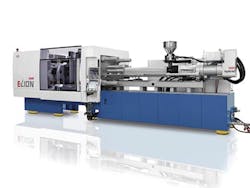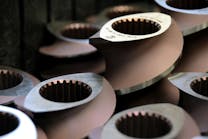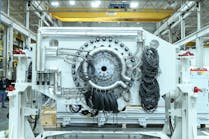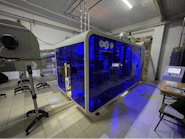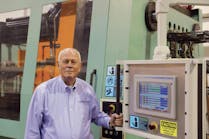Manufacturers of injection compression molding (ICM) equipment are upgrading their machinery for cutting-edge applications.
Applying injection compression technology to stack molds is among the new trends, and the electronics sector — driven by the never-ending need to make products lighter and thinner while maintaining their strength — is also a growth area.
Sumitomo (SHI) Demag
ICM serves a variety of industries, but the thin-wall packaging market recently has taken a deep interest. One of the biggest developments in the thin-wall market over the last few years is applying injection compression technology to stack molds.
"Thin-wall packaging producers are always looking for ways to reduce part costs," said Mike Uhrain, technical sales manager — packaging for Sumitomo (SHI) Demag. "Lightweighting is the largest opportunity to achieve cost savings because resin is typically the biggest expense for that type of packaging. Through injection compression of high-speed, thin-wall packaging, it is possible to achieve thinner walls and therefore lighter parts comparable to thermoformed parts. Along with that also comes a reduction in energy consumption because the required tonnage is lower through reduced cavity pressure."
In addition to benefits such as reduced part weight, clamp tonnage and energy consumption, the improved breathability of thin-wall packaging reduces venting issues, and the evenly distributed injection pressure results in less part warping.
"We have many customers producing containers, lids and closures in single-faced molds using injection compression technology, but the mold technology for stack molds was just recently developed and patented by mold maker Plastisud in Castelnaudary, France," Uhrain said. "Together, we exhibited a 2+2 production food tray at the K show in Germany running on an El-Exis SP 420/820-2500 press. The trays were very thin and lightweight but also rigid. Properly molding the 450 length to thickness (L/T) part with 20 melt flow index PP resin requires very fast injection rates and an ultra-high-speed clamp."
That exhibit was purchased by a customer in France and went into production shortly after the event ended. "Through injection compression molding, we were able to achieve an 11 percent energy reduction and a 28 percent reduction in part weight, which would not be possible with conventional injection molding," Uhrain said.
Netstal
ICM innovation has become a major focus in recent years for Netstal. At the K show, Netstal demonstrated its ICM technology using stack molds by producing 15-ounce PP containers for margarine. They weighed 10.7 grams and were manufactured with a cycle time of 4.9 seconds on an Elion 2800-2000 press with a 4+4 stack mold from Plastisud.
Automation equipment from Machines Pagès performed the automated removal and insertion of in-mold labels. Cavities were partially filled in about 0.1 second with even results, and the platen parallelism allowed a synchronicity of 99.98 percent between the mold, machine and automation system. The machine reduced material consumption by about 20 percent compared to conventional injection molding. Material savings result from the ability of ICM equipment to produce thinner parts than those made by injection molding machines.
Because the Elion 2800-2000 has very short cycle times and the mold-open time is also quite short, the insertion of the label and removal of the margarine container must happen quickly. To reduce delays, parts are taken out on the non-operator side of the machine.
The unit was also equipped with cameras for quality control and a quick delta robot for stacking of finished packaging.
"The development of injection compression molding in stack molds is a good example of the many innovations that are being made at the moment in ICM," said Marcel Christen, head of product management for Netstal, a KraussMaffei brand. "The process basically combines the advantages of both injection molding and compression molding: higher part quality and less material consumption."
In addition to providing a "best of both worlds" combination of advantages from both processes, one of the most attractive aspects of ICM is that it doesn't require many modifications to the traditional injection molding process. As an added bonus, it doesn't require many changes to peripheral equipment, either.
"Automation, mold heating and material handling are not affected," Christen said. "The technology requires highly sophisticated mold technology and, of course, a specially equipped injection molding machine, which provides enough performance and precision to drive the complex processes repeatably."
Netstal is focused on its packaging business, where demand continues to be strong.
"Good examples include food containers, lids, cups and food trays. Naturally, flat and thin-wall parts can benefit the most from the ICM technology. Ultimately, running a stable and repeatable injection compression process requires high-quality equipment that is both powerful as well as absolutely accurate and reliable. The secret lies in the perfect synchronization of the mold closing and injection sequence," Christen said.
Sodick
Although an increasing number of businesses are taking advantage of the advances that have been made in ICM, no industry has shown more interest in the process than the electronics sector, said Kohei Shinohara, GM for Plustech, the North American headquarters for Sodick Co. Ltd., IMM Division, Kaga, Japan.
"Smartphones, tablets and large-screen displays keep getting lighter and thinner even though they are simultaneously getting even bigger," Shinohara said. Sodick's Injection Molding Machinery Division specializes in machinery for those types of high-end device components.
Two of the key advantages of injection compression technology are faster cycle times and reduced space requirements on the factory floor, due to the equipment's smaller footprint.
"One of our customers who molds 13-inch diagonal light guides managed to reduce its cycle times by 50 percent, from 50 seconds to 25 seconds, by switching from conventional injection molding to injection compression molding," Shinohara said.
"In this industry, the L/T ratio of 200 has become mainstream for the manufacture of the high-brightness light guide plates for LCD backlights. Currently, the thinnest 6-inch light guide plate is 0.35mm to 0.4mm. In the near future, however, this trend will accelerate even more, and we believe an L/T ratio of 500 will soon be required by those device companies," he said.
To meet this future demand, Sodick developed its High-Speed Injection Compression System, featuring the company's Ultimate Compression Option, which is highly repeatable and blazingly fast. "The compression speed is made possible by our proprietary linear-motor-driven servo valve, giving the unit an injection acceleration of 21.8 G-forces — 40 inches per second — making it the fastest in the world," Shinohara said.
The technology has been integrated into Sodick model HSP220EH3, which features injection pressures of up to 725,000 psi, reaches maximum clamping force in only 30 milliseconds, and enables users to mold a 6-inch diagonal plate with a thickness of only 0.25mm – the thinnest polymethyl methacrylate light guide possible without distortion, Shinohara said.
Michael T. McCue, copy editor
mmccue@plasticsmachinerymagazine.com
For more information
KraussMaffei Group USA,Florence, Ky., 859-283-0200,www.kraussmaffeigroup.us
Machines Pagès,Oakville, Ontario, 905-829-8968,http://www.machines-pages.com.cn
Plastisud USA,Mt. Vernon, Ky., 606-256-1947,www.plastisud.com/index.php/en/plastisud-usa
Plustech Inc.,Schaumburg, Ill., 847-490-8130,www.plustech-inc.com
Sumitomo (SHI) Demag,Strongsville, Ohio, 440-876-8960,www.sumitomo-shi-demag.us
